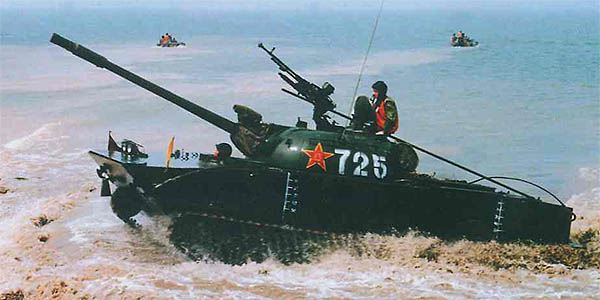TS
madokafc
Type 63 Amphbious Tank
Type 63 Amphibious Tank

Type 63 Amphibious Tank in Action
The Type 63 was China’s first amphibious tank developed from the Russian PT-76, but with a modified turret. The tank was designed for the ground forces to operate in the water regions and rice paddy fields in southern China, which are difficult for conventional main battle tanks. Later the tank was also adopted by the PLA Marine Corps for the amphibious assault operation. The tank has been gradually phased out since the late 1990s and replaced by the more capable Type 63A. A small number may still be operational for training purpose.
Programme
China obtained some PT-76 amphibious tanks from the USSR in the mid-1980s. In October 1958, the PLA decided to develop an indigenous amphibious tank based on the PT-76 design. The development programme was carried out by 201 Institute and 615 Factory. A prototype known as WZ221 was built and tested in 1959, but the design suffered from a number of problems including engine overheating. A revised design received extensive testing in 1961/62. The amphibious tank was finally approved for design finalisation in April 1963, and was officially designated Type 63. The tank entered the PLA service in the mid-1960s, but improvements on the design continued throughout the late 1960s and the 1970s.
The Type 63 amphibious tank was intended for inland river-crossing operations and amphibious landing in the costal regions. The tank can support the infantry in the attack or engage lightly armoured vehicles and fortifications, and can also be used for reconnaissance and patrol roles. The tank took part in a number of conflicts, including the Sri Lanka civil war, the 1960s/70s Vietnam War (used by the North Vietnamese Army), and the 1979 Sino-Vietnam border conflict (used by the PLA). During these conflicts, the Type 63 showed great mobility in terrains that are difficult for the heavy tanks, but its thin armour has caused heavy losses and casualties.
The PLA introduced the improved Type 63G in the mid-1990s for amphibious assault operations in the sea. The hull of the tank was enhanced for long-distance swimming from the amphibious ships to the shore. The original 86mm rifled gun was replaced by a more powerful 105mm rifled gun capable of firing the fin-stabilised discarding sabot (APFSDS) rounds. The tank was also added with laser rangefinder and a primitive fire-control for better firing accuracy. Based on the Type 63G design, a more radically modified variant known as Type 63A was introduced in the late 1990s. Other variants included Type 77-I/II amphibious APC, Type 76 amphibious armour recovery vehicle, and a 122 mm self-propelled howitzer.

Type 63 Amphibious Tank in Action
The Type 63 was China’s first amphibious tank developed from the Russian PT-76, but with a modified turret. The tank was designed for the ground forces to operate in the water regions and rice paddy fields in southern China, which are difficult for conventional main battle tanks. Later the tank was also adopted by the PLA Marine Corps for the amphibious assault operation. The tank has been gradually phased out since the late 1990s and replaced by the more capable Type 63A. A small number may still be operational for training purpose.
Programme
China obtained some PT-76 amphibious tanks from the USSR in the mid-1980s. In October 1958, the PLA decided to develop an indigenous amphibious tank based on the PT-76 design. The development programme was carried out by 201 Institute and 615 Factory. A prototype known as WZ221 was built and tested in 1959, but the design suffered from a number of problems including engine overheating. A revised design received extensive testing in 1961/62. The amphibious tank was finally approved for design finalisation in April 1963, and was officially designated Type 63. The tank entered the PLA service in the mid-1960s, but improvements on the design continued throughout the late 1960s and the 1970s.
The Type 63 amphibious tank was intended for inland river-crossing operations and amphibious landing in the costal regions. The tank can support the infantry in the attack or engage lightly armoured vehicles and fortifications, and can also be used for reconnaissance and patrol roles. The tank took part in a number of conflicts, including the Sri Lanka civil war, the 1960s/70s Vietnam War (used by the North Vietnamese Army), and the 1979 Sino-Vietnam border conflict (used by the PLA). During these conflicts, the Type 63 showed great mobility in terrains that are difficult for the heavy tanks, but its thin armour has caused heavy losses and casualties.
The PLA introduced the improved Type 63G in the mid-1990s for amphibious assault operations in the sea. The hull of the tank was enhanced for long-distance swimming from the amphibious ships to the shore. The original 86mm rifled gun was replaced by a more powerful 105mm rifled gun capable of firing the fin-stabilised discarding sabot (APFSDS) rounds. The tank was also added with laser rangefinder and a primitive fire-control for better firing accuracy. Based on the Type 63G design, a more radically modified variant known as Type 63A was introduced in the late 1990s. Other variants included Type 77-I/II amphibious APC, Type 76 amphibious armour recovery vehicle, and a 122 mm self-propelled howitzer.
0
7.3K
24
Thread Digembok
Urutan
Terbaru
Terlama
Thread Digembok
Komunitas Pilihan